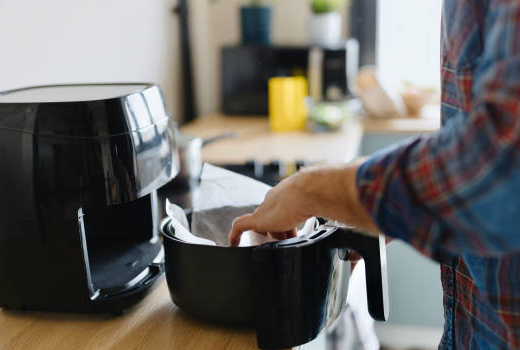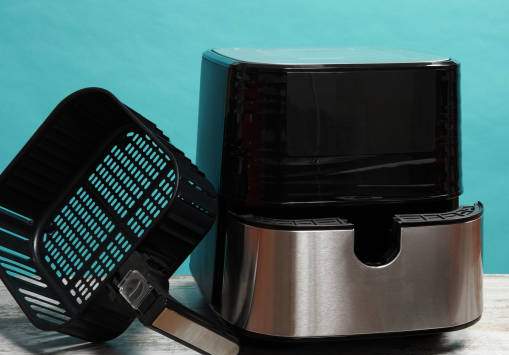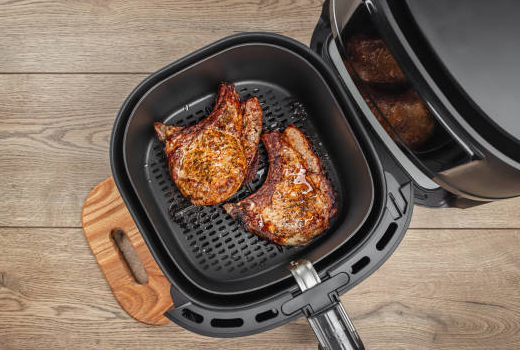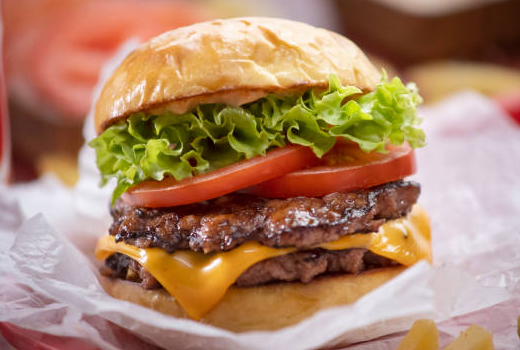9 Foods You Shouldn’t Cook in an Air Fryer

Stacy’s Parmesan Garlic Flavored Chips: A Delectable Snack Worth Savoring
September 1, 2025
Is It Okay to Use Metal Utensils on Non-stick Cookware?
September 6, 2025Air fryers are often hailed as near-magical kitchen appliances—they can cook almost anything, and somehow, they make food crispy, golden, and utterly irresistible. But while air fryers skillfully handle a wide variety of foods, it’s good to know which ones to avoid, as they don’t hold up well to this cooking method. This doesn’t necessarily mean they’re inedible, but some might make a mess, or simply taste better if you use other cooking methods. Here’s why you should avoid cooking bacon in your air fryer, and why many other foods should also be on your “no-fry” list.
Foods Not Suited for Air Frying
1. Wet Battered Foods
Many breaded recipes, like chicken tenders and fried pickles, cook perfectly in an air fryer. However, if food is coated in a wet batter (like a corn dog) without a breading layer, it likely won’t get crispy and appealing. Because the food must rest on the air fryer’s rack, the wet batter is prone to sticking. The batter might also drip onto the air fryer’s interior before the food is fully cooked, unless you use a liner.
Instead, use a traditional deep fryer for wet-battered foods. The hot oil sets the coating much faster than an air fryer, leaving less residue, and you’ll still get a golden, crispy exterior.
2. Kale and Other Leafy Greens
It’s not that cooking kale in an air fryer is impossible. The main issue with kale and other leafy greens is their light weight, which means the circulating air in the fryer can blow the leaves around. This can result in unevenly crispy, wrinkled greens. If you do try cooking greens in your air fryer, make sure they are completely coated in oil and seasoning to help prevent them from flying around. Unlike most other foods, you can’t reduce the amount of oil when air frying greens, which negates one of the air fryer’s big advantages, so kale should be on the “air fryer no-go” list.
You might have more success making crispy leafy greens in the oven. A traditional oven doesn’t have circulating heat, so you don’t have to worry about leaves blowing around. Consistent heat can still yield delicious, crispy greens, and it’s easier to ensure even cooking.

3. Liquids
Liquids release steam when heated, which can damage your air fryer. Do not put liquids in the basket for poaching, simmering, or boiling food. Use your stovetop for these cooking methods. We also recommend avoiding foods with excessive sauces in your air fryer.
4. Most Grains, Including Pasta
Some grains, like French toast sticks, can be cooked in an air fryer. But anything traditionally cooked in boiling water, such as pasta, quinoa, and rice, is not suitable for air frying. However, if you have rice that’s already cooked, you can add a bit of oil and make delicious fried rice (as long as you have a pan that fits in the cooking basket). Raw grains are not suitable for air frying because they need to absorb moisture during the cooking process.
Cook pasta, rice, oatmeal, and other grains on a traditional stovetop. Or, if you want to keep things off the range, most grains soften quickly in a pressure cooker or slowly in a slow cooker.
5. Popcorn
Popcorn kernels are another example of food not suitable for air frying because they share the same issue as leafy greens. The circulating heat can blow them around the air fryer, making for a huge mess to clean up (and potentially damaging the appliance). You’re also likely to end up with a lot of unpopped kernels, as popcorn works best under high, consistent heat.
Microwave popcorn is always a reliable option, but if you want to pop kernels yourself, a skillet on the stove works well. You can check if the pan is hot enough before pouring in a cup of kernels, giving you control over the oil and seasonings.
6. Some Cheeses
Not all cheeses are off-limits for the air fryer—it’s fine to fry some cheese if you give it a coating, like with mozzarella sticks, and keep the cooking time short (under 5 minutes). But most cheeses melt quickly, meaning if you put them in an air fryer without any coating or lining to insulate them, they’ll just melt. Cheese can also burn and stick to the basket, making a significant mess.
If you need to melt cheese for dips or fondue, use the stovetop or a slow cooker. However, if you have cheeses with a higher melting point that are meant for grilling, such as halloumi or bread cheese, you can air fry them for a gooey, crispy, and delicious result.

7. Eggs
They’re not entirely off-limits, but there are usually better ways to cook eggs than in an air fryer. You can “bake” eggs in a small ramekin in the fryer, or cover cooked eggs with sausage to make air-fried Scotch eggs. But if you’re aiming for a runny poached egg or fluffy scrambled eggs, the stovetop remains the best option. Most air fryer foods require minimal stirring and flipping while cooking, but many egg recipes need a bit more attention than an air fryer provides. They can also make a significant mess if not cooked properly.
8. Large, Bone-In Cuts of Meat
Air fryers are not suitable for cooking large, bone-in cuts of meat. If you’re looking to roast a whole chicken or a bone-in beef roast, the oven is your best bet. Air fryers can’t cook these meats evenly, and the meat might appear cooked through when it’s actually overdone or still raw in spots.
9. Bacon
Some chefs rave about air fryer bacon, but it’s best to avoid this method. Never cook bacon in an air fryer because it’s a high-fat food. It releases a lot of grease during cooking, which will coat the bottom and interior of your air fryer (and is a pain to clean). Too much grease can also cause the fryer to smoke, which is definitely something you don’t want while cooking. Plus, since bacon is already greasy, it doesn’t take full advantage of one of the air fryer’s biggest selling points: less oil in cooking.
There are many other ways to cook crispy, delicious bacon. The stovetop, microwave, oven, or even a grill are all better options. It’s also easier to monitor the bacon’s progress and flip it as needed during cooking.



